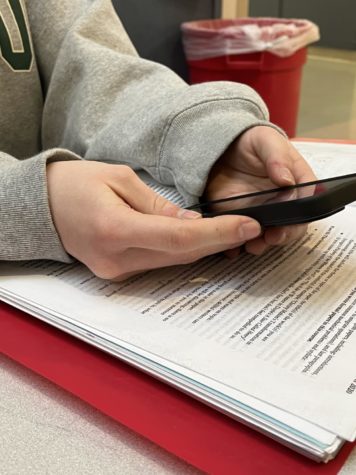Cellphones in the Classroom

Undoubtedly, student usage of cellphones in school has increased over the past decade. But are there pros to phones being allowed in class? Should they even be allowed at all?
According to teachers and recent studies, cellphone use in the classroom has negatively impacted learning and the demeanor of students. “I have 100% noticed the negative effects of cellphones in the classroom. I’ve had kids in the past watching movies, playing games, and texting while in class. Their focus is completely shifted because of cellphones and the “on” and “off” focus is detrimental,” says Melanie Mahoney, a teacher in the science department. “If a student is on a cellphone during class and it is a situation where the cellphone is not needed for the lesson, I find it to be a big distraction. Kids are very distracted by notifications, they see a notification and immediately want to check it and lose focus.” Mahoney’s observations check out with a 2013 study by Dr. Delaney Ruston who compared two groups of college students, one who used their cellphones in class and another who did not. The students who were not using their cellphones wrote 62% more in their notes, and scored a letter grade and a half higher on a multiple choice quiz than students who were actively using their phones during class. Furthermore, in a 2017 study by Dr. Seungyon Lee of the University of Arkansas at Monticello, four different groups of participants watched a video lecture in four different cellphone conditions, then were given a test on the information in the video. Those who had their phones taken away during the lecture performed better on the test than those who had their cellphones during the lecture. “A person may miss key pieces of information and opportunities to engage with classmates and the curriculum,” replied Greg Gammons, a wellness teacher, when asked how cellphones affect participation.
In addition to the harmful academic impacts cellphones cause in the classroom, they also reflect a negative message to teachers and students. “When you’ve spent time preparing a lesson, and kids are on their phones, there’s a level of respect that isn’t present. Every time a teacher has to tell a student to get off their phone, it takes away from the other students who are engaged in the lesson,” adds Mahoney. “I definitely think having my phone on me in the classroom provokes the constant want to check my phone which I feel takes away from whatever I’m doing in class, however, it’s nice to have in case of emergency, it kind of makes me feel safe knowing that I can be contacted in case something bad ever happened,” says Ben Schwartz, an LS Sophomore. The security mobile phones can provide in case of an emergency may contradict the learning disadvantages when considering a cellphone ban – not to mention the fact that cellphones are often the only way low-income students can access the internet. Concerns such as safety and equity are the main reasons many cellphone policies or bans have been reversed all around the country. Take the NYCDOE (New York City Department of Education) for example, in March of 2015, they removed their district wide cellphone ban due to the disapproval from parents and students. The cellphone-in-the-classroom discussion has been a decade-long issue that has challenged parents, students, and school committees nationwide.

